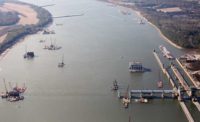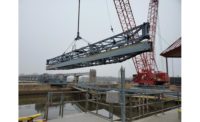After 24 years of construction, the Olmsted Locks and Dam may finally alleviate barge traffic on the Ohio River—next year. Only two massive precast “shells” need to be set in the river this year. After that, some minor cleanup work remains in the nearly quarter-century-long major infrastructure project.
Since the 1990s, ENR has written about the need to replace the failing locks and dams 52 and 53, respectively 85 and 86 years old, on the river just above where it meets the Mississippi at Cairo, Ill. (ENR 9/20/97 p. 20 and 11/14/11 p. 48). Their replacement, Olmsted, has been touted as both a necessary, state-of-the-art modernization and as a boondoggle that has caused other Army Corps of Engineers projects to be pushed further down the road because of its increasing schedule and cost overruns. Olmsted’s original authorized cost, $775 million, was long ago passed, and its completion is now authorized at a cost of up to $3.1 billion.
For most replacement locks and dams built over the last century, the USACE built cofferdams to hold back the river to enable workers to construct dams on dry river bottoms.
With Olmsted (named after the town along the river in Illinois where it’s being constructed just south of Lock 53), the USACE and its joint-venture design team, Sverdrup/Gerwick, embraced new methods for the dam’s construction by precasting up to 3,500-ton concrete shell sections on land and then lowering them precisely to location within the active river. This “in-the-wet” technique, an innovation brought in by general contractor AECOM, has been repeatedly confirmed by Corps engineers and independent analyses as an effective construction technique.
But getting that work done was another story.
It took developing new construction practices, perfecting the capacity to measure precise tolerances in deep and muddy water and designing and building equipment capable of lifting, carrying and placing giant concrete shells.
“Could it be done with more conventional construction? Could we have done that with smaller shells or smaller equipment on a smaller scale?” asked Mike Braden, Olmsted division chief for the USACE, who is responsible for overseeing execution of the project. “It all depends on what the individual application is. One benefit that we have seen from doing Olmsted in-the-wet is we have had minimal impact on the commercial towing industry. Given Olmsted’s location—the busiest stretch of the Inland Waterways—it was very important to not disrupt that flow of commercial navigation.”
Mick Awbrey, the Corps’ Olmsted construction manager, put the figure at 92 million tons of commodities passing through this stretch of the Ohio annually. By keeping the river open for the entire construction process, the only impediment to traffic is limiting tow configurations to one tug towing a three by five arrangement of barges, rather than the open river configurations of up to seven by seven used on the lower Mississippi.
Navigating The River
From 1993 to 1995, Balfour Beatty initiated the first major construction effort by building a cofferdam to facilitate the construction of twin 1,200-ft lock structures in-the-dry by joint venture Atkinson Dillingham Lane, and which were ultimately completed in 2002.
While wrapping up the locks, the Corps also awarded a contract in 1999 for construction of the upstream and downstream approach walls that commercial tows used to align themselves while transiting the locks. Designed by INCA Engineers, the concept borrowed upon details used in the construction of several floating bridges in the Northwest and allowed both offsite fabrication and mitigated the foundation challenges associated with building a very tall, relatively thin cross-sectional structure in a high seismic zone.
Massman Construction built 300-ft to 500-ft wall segments in a precast/graving yard in Paducah, Ky., post-tensioned the segments together to comprise the required wall lengths (the longest being approximately 1,500 ft), floated each down the Ohio River and pinned them into place.
In 2004, a cost reimbursement construction contract for the dam, using the in-the-wet method, was awarded to a joint venture of Washington Group and Alberici, in which Washington Group was subsequently acquired by URS and, ultimately, AECOM. While the permanent features were fully designed by the Corps’ architect-engineer of record, the construction means and methods presented were only concepts. The innovative engineering required significant time and effort to be successful.
The original design concept, (derived in the 1990s), was to build the up to 3,500-ton precast shells on land and slide them into water on a skid system. Ultimately, the concrete shells were simply too fragile for such movements. An alternate method utilizes a super gantry crane to travel across the five precast positions in the yard and allow transfer to a specially designed cradle used to carry the shell down the incline to a catamaran barge on the river for transport and final set-down. Strand jacks atop the 10-story super gantry and the catamaran barge facilitate lifting and setting the shells precisely into place.
Various design aspects in the 1990s plan needed to be revisited simply because of technological advances. The tainter-gated section of the dam used radio-controlled gates with hydraulic power units and direct connect cylinders controlled by computer software. All these operations needed updates to reflect current state-of-the-art technology and to meet increasing security protocols.
To prep for construction, crews built a ready-mix plant and rebar fabrication/bending yard on site, since the nearest suppliers were more than an hour away. The ground below the site had to also be built up with dirt dredged from the bottom of the river.
Construction Season
Once construction activities began, however, USACE and AECOM/Alberici got a much better feel for production rates. What rolled out of the 2010 production season was “Here’s where the learning curve is, what can we get better at and what’s being constrained by the construction process,” Braden said.
The process was limited, at the time, to a June to November season to set shells, drive the many piles needed to anchor the pieces of the dam and to match the shells to the piles at 0.5-in. tolerances. Trimble total stations using GPS coordinates were used to place all of the pieces of the dam within tolerances.
“Implementing a never before used method of construction—in-the-wet—our AECOM team will have built the largest inland water navigation installation ever built in the U.S., all while allowing for an uninterrupted flow of commerce on the Ohio River,” says Dan McQuade, president, construction services, AECOM.
The strand jacks provided by Dorman Long Technology emerged as an unsung hero of the project, according to project officials. Typical construction of the tainter-gate section of the dam would have meant placement with two or three cranes. AECOM came up with means and methods by which crews floated the sections in via a single barge and then mounted strand jacks to the existing concrete structure. This provided a controlled fit and eliminated safety hazards.
After the first season, both AECOM and the USACE said they had a much better feel for how to build and place the shells, what could be accomplished by the lifting elements and divers in the river and when and how the project would be delivered. However, the project ran up against the authorization ceiling that Congress originally established necessitating preparation of a post-authorization change report in 2012.
The project came within weeks of shutting down for lack of funding, and the USACE put together contingency plans for how to secure the site and what that would mean to labor and personnel. USACE senior leaders and government stakeholders met in Pittsburgh to decide what to do and even considered the option of switching, midstream, to an in-the-dry construction method.
In the end, Congress reauthorized the project in 2013, and the new authorization allowed the project delivery team to align construction planning with an efficient funding stream including advancing critical milestones and diving support outside of the traditional season.
“We spent a little more money to do some river work in December when the elevation is higher and the velocity is faster, so that allowed us to advance the schedule quite a bit. In the long run, we’re saving much more money,” says Braden.
The new measures allowed the project to advance years ahead of what was, in 2012, expected to be a 2022 operational milestone and set a 2018 forecast. By employing this approach, the USACE also mitigated expenditure of approximately $250 million in contingency reserves necessary at an 80% confidence level.
When Olmsted opens to traffic, project officials say it will deliver nearly $640 million in net annual economic benefits to the nation from replacement of the two nearly 100-year-old locks and their maintenance costs.










Post a comment to this article
Report Abusive Comment